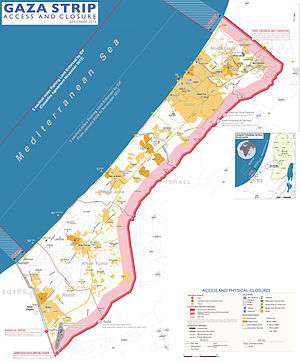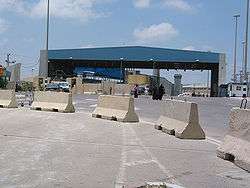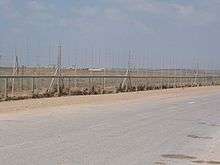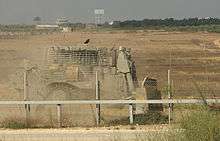Israel–Gaza barrier
The Israel−Gaza security barrier is a border barrier first constructed by Israel in 1994 between the Gaza Strip and Israel. The barrier runs along the entire land border of the Gaza Strip.[1] Entry into the Gaza Strip by land is through five crossing points: the northern Erez Crossing into Israel, the southern Rafah Crossing into Egypt, the eastern Karni Crossing used only for cargo,[2] and the other cargo crossing points, the Kerem Shalom Crossing on the border with Egypt and the Sufa Crossing farther north.[3]

| Blockade of the Gaza Strip |
|---|
|
| Crossings |
| 2004 |
| Philadelphi Accord |
| 2006 |
| Economic sanctions |
| 2007 |
| Fatah–Hamas battle |
| 2008 |
| 2009 |
| Viva Palestina "Lifeline 3" |
| 2010 |
|
Other convoys
|
| 2011 |
| 2012–2014 |
| Gaza's Ark |
| 2015 |
| Freedom Flotilla III |
| 2016 |
| Women's Boat to Gaza |
| 2018 |
| Just Future For Palestine Flotilla |
Background
In 1993, Israel and the Palestinian Liberation Organization signed the Oslo Accords establishing the Palestinian Authority with limited administrative control of the West Bank and Gaza Strip. Pursuant to the Accords, Israel has continued to maintain control of the Gaza Strip's airspace, land borders (with the exception of Gaza's border with Egypt, abandoned by Israel in 2005), and territorial waters. Israel started construction of the first 60 kilometers (37 mi) long barrier between the Gaza Strip and Israel in 1994. In the 1994 Interim Agreement on the West Bank and the Gaza Strip, it was agreed that "the security fence erected by Israel around the Gaza Strip shall remain in place and that the line demarcated by the fence, as shown on the map, shall be authoritative only for the purpose of the Agreement"[4] (i.e. the barrier does not necessarily constitute the border). The barrier was completed in 1996.
From the Israeli perspective, the Israel–Gaza Strip barrier is a security barrier intended by Israel to control the movement of people between the Gaza Strip and Israel, to stop the entry of arms into the territory.
The Israel-Gaza Strip barrier has met with opposition and protests from some Palestinians.[5]
The barrier was largely torn down by Palestinians at the beginning of the Al-Aqsa Intifada in September 2000, followed by many terror attacks.[6] The barrier was rebuilt between December 2000 and June 2001. A one-kilometer buffer zone was added, in addition to new high technology observation posts. Soldiers were also given new rules of engagement,[6] which, according to Ha'aretz, allow soldiers to fire at anyone seen crawling there at night illegally into Israeli territory.[7] Palestinians attempting to cross the barrier into Israel by stealth have been shot and killed.[8]
The barrier's effectiveness prompted a shift in the tactics of Palestinian militants who commenced firing Qassam rockets and mortars over the barrier.[6][9]
The barrier has been effective in preventing terrorists and suicide bombers from entering Israel from Gaza. Since 1996, virtually all suicide bombers trying to leave Gaza have detonated their charges at the barrier's crossing points and were stopped while trying to cross the barrier elsewhere.[10][11] From 1994 until 2004 a suicide bomber originating from within the Gaza Strip successfully carried out an attack in Israel (the March 14, 2004 attack in Ashdod).[12]
In 2005, Israel unilaterally withdrew its troops from the Gaza Strip, along with thousands of Israeli settlers. Israel thus claims to have ended the occupation. However, this claim has been challenged on the basis that Israel continues to exercise control over Gaza's territorial waters and airspace, despite Gaza not being part of Israel and Gazans not having Israeli passports.[13]
In June 2007, Hamas took over Gaza, ousting the forces of Fatah, the faction led by Palestinian Authority President Mahmoud Abbas and effectively separating Gaza from the West Bank in terms of its administration. Hamas had won legislative elections in January 2006. Israel intensified its blockade of the Gaza Strip in June 2007, when Hamas took power and began increasing its rocket fire into Israel.
On 27 December 2008, Israel launched the Gaza War, consisting of airstrikes and ground incursions against targets in the Gaza Strip, with the stated aim of stopping the rocket fire[14] from and arms smuggling into the territory.[15][16] The war ended on 18 January 2009, when both sides ceased military action.[17][18] Israel completed its withdrawal on 21 January,[19] and thousands of rockets and mortars have been fired from the Gaza Strip since.
Support for a similar Egypt–Gaza barrier
Palestinian Authority President Mahmoud Abbas declared support for the Egypt–Gaza barrier, adding: "It is the Egyptians’ sovereign right in their own country. Legitimate supplies should be brought through the legal crossings",[20] although he made no such comment towards Israel's sovereign rights. The United States announced its support for the Egypt-Gaza barrier saying it would prevent weapons smuggling.[21] Cairo's main Al-Azhar University officially backed the government's decision for an Egypt-Gaza barrier saying that it was the "state's right to build along its walls facilities and obstacles that will enhance its security."[22]
Crossing points
There are three main crossing points out of the Gaza Strip: the northern Erez Crossing into Israel, the southern Rafah Crossing into Egypt, and the eastern Karni Crossing used only for cargo.[2] Other cargo crossing points are the Kerem Shalom border crossing on the border with Egypt and the Sufa Crossing further north.[3]
From the Palestinian perspective, the crossings are crucial to the economy of the Gaza Strip and to the daily needs of the population.[2] Chief Palestinian Authority negotiator Saeb Erekat described closures of the crossings and said they have "proven to be counter-productive".[3]
Erez Crossing

The Erez Crossing is a pedestrian and cargo crossing into Israel, located in northern Gaza. The crossing is currently restricted to Arab residents under the jurisdiction of the Palestinian Authority and to Egyptian nationals or international aid officials only, and is closed to tourists. Palestinians who have a permit to work in Israel or those with permits allowing them to receive free medical treatment or to visit immediate family who are in prisons may use this crossing when it is open for pedestrian travel.[23]
Though 5,000 Palestinians are permitted to use the Erez Crossing to go to their places of work inside Israel, the crossing was frequently closed by the Israeli authorities, impeding their ability to get to work.[2] Additionally, the permits issued have not always been honoured by soldiers, who in some cases confiscated them at the crossing.[23]
Karni Crossing

The Karni Crossing is used for cargo traffic. The Karni crossing is often closed by Israel after regular attacks by Palestinian militants on Israeli targets.[3] Israeli officials have cited ongoing threats against its security, inaction against terrorist group activity on the part of the Palestinian Authority, and a lack of other choices.[3]
Tunnels under the barrier
On 25 June 2006 Palestinians used an 800-metre tunnel dug under the barrier over a period of months to infiltrate into Israel. They attacked a patrolling Israeli armored unit, killed two Israeli soldiers, and captured another one, Gilad Shalit.[24]

Between January and October 2013, three tunnels under the Israel border were identified – two of which were packed with explosives.[25] The discovery of similarly constructed tunnels in other parts of the world have led to updated threat assessment estimates.[26][27]
In the summer of 2017, Israel began the construction of a border wall which stretched several meters underground to counter tunnel assaults.[28] The structure is equipped with sensors to detect future tunnel construction. Concrete for the structure was produced using five concrete factories dedicated to the project and about 10 meters was completed daily. The structure was placed entirely on Israeli land.[29]
See also
- Israeli West Bank barrier
- Gaza–Egypt border
- 2018 Gaza border protests
References
- Barnard, Anne (2006-10-22). "Life in Gaza Steadily Worsens". The Boston Globe.
- Myre, Greg (2006-03-04). "Gaza Crossing:Choked Passages to Frustration". The New York Times.
- Dudkavitch, Margo; Halpern, Orly (2006-03-01). "Palestinians Reject Use of Kerem Shalom for Gaza Cargo". The Jerusalem Post.
- "Draft Agreement on the Gaza Strip and Jericho Area (archived copy)" (PDF). Palestine Israel Journal of Politics, Economics and Culture. 1994-04-26. Archived from the original (PDF) on August 12, 2007.
- "Palestinians Protest The Israeli Wall Surrounding The Gaza Strip - International Middle East Media Center". Imemc.org. 2010-03-10. Retrieved 2011-05-28.
- Almog, Major General Doron (2004-12-23), Lessons of the Gaza Security Fence for the West Bank, 4 (12 ed.), Jerusalem Center for Public Affairs
- Harel, Amos; Issacharoff, Ari (2007-01-26). "IDF Kills Teen Crawling Toward Gaza Fence". Ha'aretz, English edition.
- "Unarmed Palestinians Killed Scaling Gaza Fence". CTV. Associated Press. 2002-12-12.
- Burston, Bradley. "Background: Hamas vs. Abbas:The Lethal Wildcard, A Profile". Haaretz. Archived from the original on February 12, 2007. Retrieved 2007-05-02.
- "The Gaza Strip: Maps and Fact File". CTV. 2006-07-04.
- Bard, Mitchell (2007-01-09). "Israel's Security Fence". Jewish Virtual Library. Retrieved 2007-05-03.
- Barasch, Daniel B.; Qadir, Lala R. "Overcoming Barriers: US National Security Interests and the West Bank Separation Barrier": 20. Cite journal requires
|journal=(help) - "Gaza crisis: key maps and timeline". BBC News. 2009-01-06. Retrieved 2011-05-28.
- TIMELINE – Israeli-Hamas violence since truce ended, Reuters 05-01-2009
- Bright, Arthur. Israel set to launch ‘limited operation’ in Gaza, Christian Science Monitor, December 26, 2008.
- Rory McCarthy in Jerusalem (2009-09-16). "Israel rejects war crimes findings of UN Gaza inquiry | World news | guardian.co.uk". Guardian. London. Retrieved 2010-05-08.
- "Hamas leader in Syria announce one-week ceasefire in Gaza". Xinhua. 2009-01-18. Archived from the original on 2009-01-29. Retrieved 2009-08-03.
- "Hamas agrees to 1-week ceasefire". CBC News. 2009-01-18. Retrieved 2009-08-03.
- Hamas, Israel set independent cease-fires, CNN International; Last Israeli troops 'leave Gaza', BBC News, January 21, 2009.
- Milne, Seumas (31 January 2010). "Mahmoud Abbas: Israel's West Bank occupation leading to one-state solution". The Guardian. Retrieved 11 September 2016.
- "US supports Egyptian underground barrier on Gaza border". Ynet, January 12, 2010.
- Nahmias, Roee. Arab protests against Egypt's Gaza border wall spread, Ynet, January 4, 2010
- "Report by the Palestinian Centre for Human Rights on the Closure imposed by Israel on the Gaza Strip". Palestinian Centre for Human Rights. Closure Update No. 9. 1996-05-16. Archived from the original on February 19, 2008.
- "Palestinian Militants Attack Border". CBS News. 2006-06-25.
- Fiske, Gavriel and Ginsburg. (13 October 2013). "IDF blames Hamas for ‘terror tunnel’ from Gaza to Israel Defense minister halts transfer of construction supplies to the Strip after 500 tons of cement used to construct underground passage"
- Lichtenwald, Terrance G. and Perri, Frank S. (2013). "of-smuggling-tunnels.pdf Terrorist Use of Smuggling Tunnels" International Journal of Criminology and Sociology, Volume 2, pp. 210-226.
- Lichtenwald, Terrance G. and Perri, Frank S. (2011)."Smuggling Tunnels: The Need for a Transnational Analysis" Inside Homeland Security Volume 9, Issue 1.
- "Israel Speeds Up Underground Border Wall To Block Gaza Tunnels". NPR.org. Retrieved 2018-04-21.
- Sanchez, Raf (2018). "Israel unveils plans for 40-mile underground wall around Gaza". The Telegraph. ISSN 0307-1235. Retrieved 2018-04-21.
External links
- Makovsky, David (Mar 2004). "How to Build a Fence". Article preview. Foreign Affairs Magazine. Archived from the original on April 5, 2007.